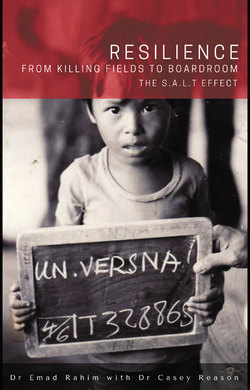Читать книгу Resilience - From Killing Fields to Boardroom - Casey Reason - Страница 3
На сайте Литреса книга снята с продажи.
Introduction
ОглавлениеUltimately, leadership is not about glorious crowning acts. It's about keeping your team focused on a goal and motivated to do their best to achieve it, especially when the stakes are high and the consequences really matter. It is about laying the groundwork for others' success, and then standing back and letting them shine. - Chris Hadfield
Introduction: The Boardroom
With the phone to his ear, Emad directed his gaze toward the window without really seeing the breathtaking beauty of the snow-covered Chicago skyline below his 20th floor hotel suite. The scene provided a picture-perfect backdrop for Emad to lose himself in reflection.
“Well, yes, getting ready for the meeting, is a whole lot easier when you have good news to share with all of your stakeholders and clients, ” he concluded with a smile.
Indeed, as the University Dean for one of the largest publicly-traded proprietary schools in the nation, Emad had very good news to share with the CEO and the rest of the administrative board. He was prepared to report that his online MBA degree program was listed in the Financial Times, and was now ranked among the top ten schools globally, and top six nationally by CEO Magazine. The Military Times had also ranked his Business Department in the top fifteen among traditional military institutions, and several articulation agreements with some well-respected institutions were in the fold. Emad helped to lead the design and creation of several new degree programs that were growing in enrollment, and the business school had recently earned several respected program accreditations. Under his leadership, and with the help of his staff and colleagues, they had achieved a phenomenal transformation within a short period of time; nearly as wonderful as his beautiful, panoramic view.
While his business colleague on the other end of the phone rattled off accolades and discussed future opportunities, Emad’s eyes drifted from the falling snow to his computer desktop, and he randomly clicked on an untitled folder. Not recalling the contents, he clicked on an image that drew his attention. It was his first known photograph from the Cambodian concentration camp in the Killing Fields where he was born.
Emad’s posture and attitude suddenly changed as he gazed at his younger self; for a moment, he felt sad, scared and confused. On the other end of the line, his colleague’s voice faded away as Emad’s thoughts sped to the distant past and the little boy’s journey; from the Killings Fields of Cambodia, to the refugee camps of Thailand, and eventually to Brooklyn and Syracuse New York. Emad thought about his father, who had been tortured and executed by the Khmer Rouge regime, and of his older brother who died of starvation and sickness in those concentration camps. Emad remembered the abuse inflicted by his stepfather and being homeless as an adolescent. His mind lingered in the past, as he looked, pensively, at the picture of himself as a scrawny three-year-old.
Those scared little eyes looking back at him had already witnessed atrocities, countless killings and abuse. That young boy had seen and experienced so many terrifying events; they were the type of images that had developed into nightmares and post-traumatic stress syndrome. Emad wanted to reach into the picture in a futile attempt to protect his innocence.
“Emad… Emad…” His colleague’s voice brought him back to the present, to the telephone conference that was still in progress.
“Oh, sorry, I’m here. Alright, everyone, I’ll talk to all of you soon. I’ve got to get ready for another meeting with the senior leadership team at our other business unit. It’s going to be a crazy busy day. Thank you for your time, and have a great day, everyone. ”
Emad hung up the phone and turned back to his desk, wincing at the slight twinge that was an unwelcome reminder of the bullet wound he’d received in his leg. Indeed, that lingering pain, along with the dull ache from being stabbed in his shoulder, were familiar sensations. They and the many scars left by years of abuse and violence lay hidden beneath his clean, white, Oxford button-down shirt and tailored three-piece suit.
In the upcoming meeting his colleagues would be talking about the perils of competition, and potential for hostile takeovers in the market. Emad thought about the racism and prejudice his family had endured as refugees; the hostility he faced growing up in a violent neighborhood and as a hustler trying to make ends meet in a poverty-stricken community in New York. After surviving his past, the news of falling stock prices wasn’t even remotely intimidating. Emad grinned at the idea of his colleagues talking about preparing for battle in the boardroom when he remembered preparing for literal gang-related fights. He had earned his seat at the boardroom table. Born Veasna Un and now known as Dr. Emad Rahim; but it was those Killing Fields and the subsequent challenging chapters in his life that defined him today.
Emad’s past; those morose, maniacal and unconscionable circumstances became his proving ground, and shaped his courage and determination. In fact, it was how he had responded to those challenges that made all the difference. He and his family weren’t unique. Many other friends, neighbors, and family members had lived through the same atrocities and suffered unthinkable consequences. So what truly made him different? What actions, behaviors and mindset changed the course of his future? How was he able to take control of his destiny and conquer his fear?
